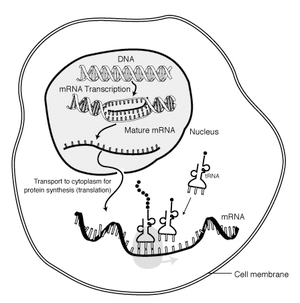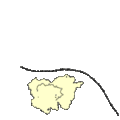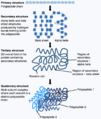Protein biosynthesis facts for kids
Protein biosynthesis (say: bio-SIN-thuh-sis) is the amazing process where cells create proteins. Proteins are super important for almost everything a cell does, from building structures to carrying out chemical reactions.
This process involves many steps. First, cells get amino acids, which are like the building blocks of proteins, either from food or by making them. Then, special instructions from your genes (which are made of DNA) are used to put these amino acids together.
The main steps are:
- Transcription: Copying the gene's instructions into a temporary message called messenger RNA (mRNA).
- RNA Splicing: Cleaning up and editing the mRNA message.
- Translation: Reading the mRNA message to link amino acids together and form a protein chain.
- Protein Folding: The protein chain folds into a unique 3D shape so it can do its job.
Sometimes, one gene can even make different kinds of proteins through a process called alternative splicing. This is like having one recipe that can be used to bake different types of cookies!
The way proteins are made is a bit different in very simple cells called prokaryotes (like bacteria) compared to more complex cells called eukaryotes (like plant and animal cells), but the basic idea is the same for all living things.
Contents
How Cells Make Proteins
Making a protein is a bit like following a detailed recipe. The recipe is stored in your DNA, inside the nucleus of your cells.
Step 1: Transcription – Copying the Recipe
The first step is called transcription. Think of it as making a temporary copy of a recipe.
- Your DNA contains all the instructions (genes) for making proteins.
- When a cell needs a specific protein, a special enzyme called RNA polymerase reads the DNA gene.
- It then creates a copy of that gene in the form of a messenger RNA (mRNA) molecule. This mRNA is like a single-use copy of the recipe that can leave the nucleus.
Step 2: RNA Splicing – Editing the Message
After transcription, the mRNA copy isn't always ready to use right away, especially in complex cells (eukaryotes).
- The newly made mRNA (called pre-mRNA) often has parts that aren't needed for the final protein. These are called introns.
- The important parts, called exons, are kept.
- A process called RNA splicing cuts out the introns and joins the exons together. This creates a mature mRNA molecule that contains only the necessary instructions.
Step 3: Translation – Building the Protein Chain
Now, the mature mRNA recipe leaves the nucleus and travels to the cytoplasm. This is where the protein-building factories are located.
- Tiny cell parts called ribosomes attach to the mRNA. Ribosomes are like the chefs in our recipe analogy.
- The ribosome reads the mRNA message three letters at a time. Each three-letter code (called a codon) tells the ribosome which amino acid to add next.
- Another type of RNA, called tRNA (transfer RNA), brings the correct amino acid to the ribosome.
- The ribosome links these amino acids together, one by one, forming a long chain. This chain is called a polypeptide chain.
Step 4: Protein Folding – Giving the Protein its Shape
Once the polypeptide chain is complete, it's not yet a working protein. It's just a long string of amino acids.
- For a protein to do its job, it must fold into a very specific three-dimensional shape.
- This folding process happens naturally, often helped by other proteins called chaperones.
- The final folded protein can then start performing its function in the cell. For example, some proteins act as enzymes to speed up reactions, while others build cell structures.
Post-Translational Modifications
Sometimes, after a protein has been made and folded, it might need a few more changes to become fully active or to go to the right place in the cell. These are called post-translational modifications.
- This can involve adding small chemical groups, cutting off parts of the protein, or even joining different protein chains together.
- These changes help fine-tune the protein's function or direct it to where it's needed.
Why Proteins are Important
Proteins are essential for life! They do countless jobs in your body, such as:
- Building and repairing tissues (like muscles and skin).
- Making enzymes that help digest food and carry out chemical reactions.
- Transporting substances, like oxygen in your blood.
- Fighting off infections as part of your immune system.
- Sending signals between cells.
When protein synthesis goes wrong, it can lead to health problems. For example, a small mistake in making a protein can cause conditions like sickle cell anemia.
Images for kids
See also
 In Spanish: Biosíntesis proteica para niños
In Spanish: Biosíntesis proteica para niños











